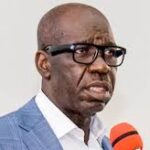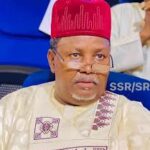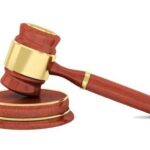The decision to convert the residence of late Alhaji Yusuf Maitama Sule, Dan Masanin Kano, to Yusuf Maitama Sule Centre for the Advancement of Democratic Politics and Good Governance has been described as a major boost for Nigerian artists. A fine artist at the Ahmadu Bello University (ABU) Zaria, Aminu Ayuba Ahmed, said this, among other contemporary issues, in this interview. Excerpt
What is your take on the recent decision by the Kano State government to convert the residence of the late Yusuf Maitama Sule (Dan Masanin Kano) to a museum and centre for politics?
To say that I am excited is an understatement. This is because the centre will provide additional opportunities for indigenous artists not only to cross fertilise ideas, but showcase their talents through exhibition.
Tracy Coker wins Blue Agency Pencil Award
Inadequate health facilities, staff shortage threaten BHCPF’s gains in Gombe
When I heard about the Governor Ganduje’s decision to convert the residence of late Dr. Yusuf Maitama Sule to a Center for the Advancement of Democratic Politics and Museum, I felt that another door of opportunities has opened for artists. I have been waiting for such an opportunity to give my contribution towards the upliftment and showcasing of local talents.
Are you saying that despite your stay in ABU, you didn’t come across any opportunity to showcase your talent?
No, that is not what I mean. ABU has done everything for me, especially during the tenure of the immediate Vice Chancellor of the university, Professor Ibrahim Garba. However, no matter one’s position and achievement, a good and responsible person will be happy to see more doors of opportunities being opened for one’s profession, especially for the younger ones.

What are some benefits of the Maitama Sule Centre to artists?
Aside from enhancing our political culture and tradition, the centre will provide opportunities for us to exhibit our talents. For example, I have painted the portraits of past Nigerian elders and leaders beginning with our First Republic leaders up to present leaders in chronological sequence. These include the portraits of our first and only Prime Minister – Sir Abubakar Tafawa Balewa; the Dan Masanin Kano; the Sardauna of Sokoto, Sir Ahmadu Bello; Chief Obafemi Awolowo up to the incumbent President Muhammadu Buhari. I hope to use the centre for the exhibition of these efforts for the world to see what Nigerian artists can offer.
I have done similar documentation at ABU, where I painted the portraits of Sir Ahmadu Bello, the Sardauna of Sokoto, which is now prominently displayed at the ground floor of the ABU’s Senate. In addition, I have painted portraits of Sir Kashim Ibrahim and some of our traditional old gates of Kano and Zazzau. As I said earlier, the former Vice Chancellor of ABU, Professor Ibrahim Garba, gave me that opportunity and those portraits are part of the attraction of many buildings of the university, especially the Kashim Ibrahim Library (KIL) among others.
From your interactions with some Nigerians, how would you describe their perception of visual art?
Visual documentation, which the Dan Masanin Kano Centre will also accommodate, is one of the methods of preserving history for the benefit of unborn generations. The Centre will also assist students of fine arts, their teachers, technologists and other Nigerians to know their history as it will preserve the paintings of historical events and personalities.
Documentation of history through painting is something that is prioritized in different parts of the world. It is on this note that I advise the good people of Kano to give the governor their maximum cooperation for the full realization of the Dan Masanin Kano Centre. Indigenous artists like me can make use of the centre for our exhibition and I pray that the centre will host my next exhibition that I titled BASMALA, which is on Islamic Calligraphy.
Is there any of your works that you always remember and cherish?
Yes. I always remember an exhibition that was hosted by the Ahmadu Bello University (ABU) that comprised the paintings of some members of the Kano royal family and other prominent personalities that hail from Kano State, my home state.
I can’t forget, particularly, how the then VC described the work as talented works of Art that were depicting the rich heritage of Kano. The VC further classified the work as a demonstration of the quality that is inherent in my department – Fine Arts, and the university in general. I always feel elated whenever I remember that event, because I did all the paintings that were exhibited that day.
The exhibition captured the royalty, icons of business/entrepreneurship and imposing cultural heritage of the famous historic city of Kano. It also attracted prominent people like the then emir of Kano, Muhammad Sanusi II; business mogul, Aliko Dangote; the Chancellor of ABU, Nnaemeka Alfred Achebe; among others. That event was a dream come true for me.
Again, that work earned me the Vice Chancellor’s Award for outstanding art of painting. The nomination added to my excitement because it was something that I never expected. Working in an environment like ABU in the midst of eminent scholars who excelled in the profession of Arts certainly humbled me when I was nominated for that award.
How did you venture into painting?
I started the art of painting at a tender age as an apprentice, before I was enrolled in school to obtain professional qualification. I had my primary and secondary education in Kano State. I later obtained National and Higher National Diploma at the Kano State Polytechnic and I joined the services of ABU’s department of Fine Arts in 2008.
Since then, drawings and paintings have become part of me. Art runs in my blood because it is something I started right from childhood. I began practicing art at Muhammad Kabir Art Studio, alia Mash KB Art, Tudun Murtala, Kano in the late 1990s. Since then, I have been into this profession up till today.
My coming to ABU’s department of Fine Arts where I interact with prominent visual artists like Professors Mu’azu Mohammed Sani, Jerry Buhari, Jacob Jari, among others, has really encouraged me to take arts more seriously. I think I was privileged that Allah has bestowed His mercy on me, hence the reason that I am where I am today.
What is your advice for the youths, especially those with interest in art?
Nigerian youths, especially those from the Northern part of the country, should have a rethink about their perception of the art of drawing and painting. One can practice this profession without necessarily engaging in drawing of human or animals. There is Islamic calligraphy, which is in high demand now. There are other types of painting and drawing that are used in decoration. These drawings and paintings can depict history, tradition or culture of Hausas and other tribes. What I am saying is that, one can earn a comfortable and decent living in this field without necessarily engaging in those areas that are seen as being prohibited by Islam.

 Join Daily Trust WhatsApp Community For Quick Access To News and Happenings Around You.
Join Daily Trust WhatsApp Community For Quick Access To News and Happenings Around You.


